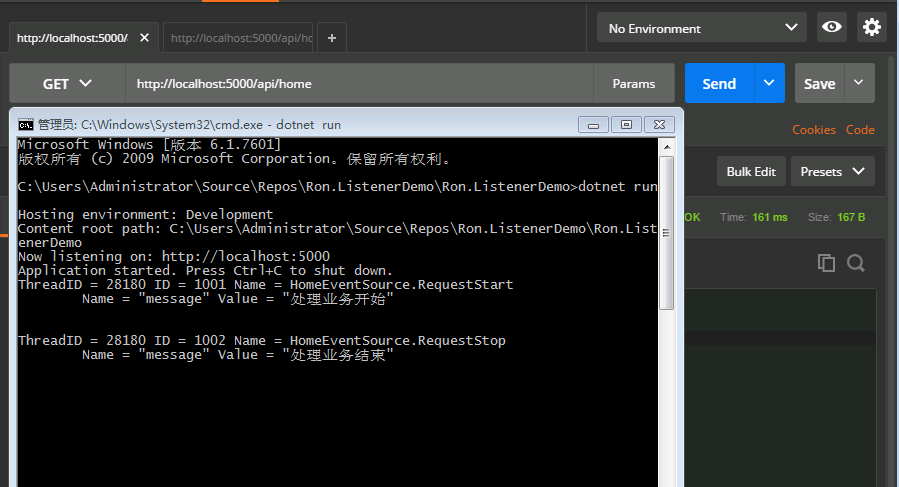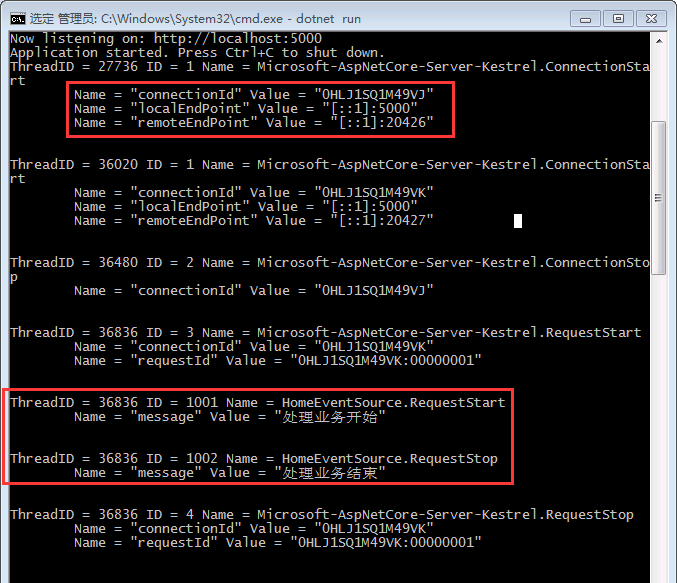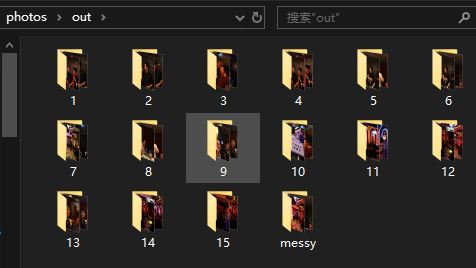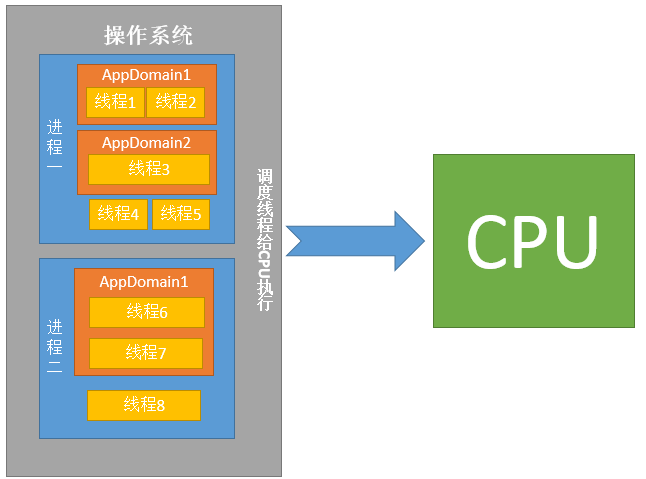前言
在 Net Core 2.2 中,官方文档表示,对 EventListener 这个日志监视类的内容进行了扩充,同时赋予了跟踪 CoreCLR 事件的权限;通过跟踪 CoreCLR 事件,比如通过跟踪 CoreCLR 事件,可以了解和收集到比如 GC,JIT,ThreadPool,intreop 这些运行时服务的行为;通过使用配置注入,我们将获得一种动态跟踪事件的能力。
1. EventListener 介绍
1.1 EventListener 中文直译为:事件侦听器
EventListener 位于程序集 System.Diagnostics.Tracing 中,该类提供了一组启用/禁用的方法,按照惯例,先来看一下源代码,了解一下其结构
|
1
2
3
4
5
6
7
8
9
10
11
12
13
14
15
16
17
18
19
20
|
public abstract class EventListener : IDisposable{protected EventListener();public event EventHandler<EventSourceCreatedEventArgs> EventSourceCreated;public event EventHandler<EventWrittenEventArgs> EventWritten;protected static int EventSourceIndex(EventSource eventSource);public void DisableEvents(EventSource eventSource);public virtual void Dispose();public void EnableEvents(EventSource eventSource, EventLevel level);public void EnableEvents(EventSource eventSource, EventLevel level, EventKeywords matchAnyKeyword);protected internal virtual void OnEventWritten(EventWrittenEventArgs eventData);} |
从类结构中可以看出,EventListener 中的方法并不多,而且从名字都可以推断出其行为,
因为该类是一个抽象类,并不能直接使用,接下来我们创建一个 ReportListener 类继承它
2. 创建自定义事件侦听器
|
1
2
3
4
5
6
7
8
9
10
11
12
13
14
15
16
17
18
19
20
21
22
23
24
25
26
27
28
29
30
31
32
33
|
public class ReportListener : EventListener{ public ReportListener() { } public Dictionary<string, ListenerItem> Items { get; set; } = new Dictionary<string, ListenerItem>(); public ReportListener(Dictionary<string, ListenerItem> items) { this.Items = items; } protected override void OnEventSourceCreated(EventSource eventSource) { if (Items.ContainsKey(eventSource.Name)) { var item = Items[eventSource.Name]; EnableEvents(eventSource, item.Level, item.Keywords); } } protected override void OnEventWritten(EventWrittenEventArgs eventData) { if (Items.ContainsKey(eventData.EventSource.Name)) { Console.WriteLine($"ThreadID = {eventData.OSThreadId} ID = {eventData.EventId} Name = {eventData.EventSource.Name}.{eventData.EventName}"); for (int i = 0; i < eventData.Payload.Count; i++) { string payloadString = eventData.Payload[i]?.ToString() ?? string.Empty; Console.WriteLine($"\tName = \"{eventData.PayloadNames[i]}\" Value = \"{payloadString}\""); } Console.WriteLine("\n"); } }} |
ReportListener 自定义事件侦听器的代码非常简单,只是简单的继承了 EventListener 后,重写了父类的两个方法:创建事件和写入事件
同时,还定义了一个公共属性 Dictionary<string, ListenerItem> Items ,该属性接受一个 ListenerItem 的跟踪配置集,通过配置文件注入,动态觉得哪些事件可以被写入到侦听器中
3. 配置跟踪项目
在配置文件 appsettings.json 中增加以下内容
|
1
2
3
4
5
6
7
8
9
|
{ "listener": [ { "name": "HomeEventSource", "level": 5, "keywords": -1 } ]} |
配置说明
上面的配置文件表示,定义一个事件源对象(EventSource),名称为 HomeEventSource,事件级别(EventLevel)为 5,关键字(EventKeywords)为 -1
关于事件级别和事件关键字的值,和系统定义的一致
3.1 事件级别定义
|
1
2
3
4
5
6
7
8
9
10
11
12
|
namespace System.Diagnostics.Tracing{ public enum EventLevel { LogAlways = 0, Critical = 1, Error = 2, Warning = 3, Informational = 4, Verbose = 5 }} |
3.2 事件关键字定义
|
1
2
3
4
5
6
7
8
9
10
11
12
13
14
15
16
17
|
namespace System.Diagnostics.Tracing{ [Flags] public enum EventKeywords : long { All = -1, None = 0, WdiContext = 562949953421312, MicrosoftTelemetry = 562949953421312, WdiDiagnostic = 1125899906842624, Sqm = 2251799813685248, AuditFailure = 4503599627370496, CorrelationHint = 4503599627370496, AuditSuccess = 9007199254740992, EventLogClassic = 36028797018963968 }} |
3.3 配置文件完全按照系统值定义,为了更好的使用配置文件,我们定义了下面的实体类
|
1
2
3
4
5
6
|
public class ListenerItem{ public string Name { get; set; } public EventLevel Level { get; set; } = EventLevel.Verbose; public EventKeywords Keywords { get; set; } = EventKeywords.All;} |
4. 开始使用事件侦听器
为了在应用程序中使用事件侦听器,我们需要初始化事件侦听器,你可以初始化多个事件侦听器;但是,每个事件侦听器仅需要初始化一次即可
4.1 初始化自定义事件侦听器,在 Startup.cs 文件中加入以下代码
|
1
2
3
4
5
6
7
8
9
10
11
12
13
14
15
16
17
18
19
20
|
public void AddEventListener(IServiceCollection services){ var listeners = this.Configuration.GetSection("listener").Get<List<ListenerItem>>(); Dictionary<string, ListenerItem> dict = new Dictionary<string, ListenerItem>(); if (listeners != null) { foreach (var item in listeners) { dict.Add(item.Name, item); } } var report = new ReportListener(dict); services.AddSingleton<ReportListener>(report);}public void ConfigureServices(IServiceCollection services){ AddEventListener(services); services.AddMvc().SetCompatibilityVersion(CompatibilityVersion.Version_2_2);} |
初始化动作非常简单,仅是从配置文件中读取需要跟踪的项,然后注册到 ReportListener 内部即可,为了演示事件的注册,我们需要创建一个事件源,就像配置文件中的名称 HomeEventSource
4.2 创建自定义的事件源对象
|
1
2
3
4
5
6
7
8
9
10
|
public class HomeEventSource : EventSource{ public static HomeEventSource Instance = new HomeEventSource(); [Event(1001)] public void RequestStart(string message) => WriteEvent(1001, message); [Event(1002)] public void RequestStop(string message) => WriteEvent(1002, message);} |
自定义事件源 HomeEventSource 继承自 EventSource,我们可无需为该自定义事件源进行显式命名,因为默认将会使用 HomeEventSource 类名进行注册事件
现在,我们尝试着 HomeController 去生产一个事件,看看效果
5. 生产事件
5.1 转到 HomeController,在 HomeController 的 Get 方法中使用 HomeEventSource 生产两个事件
|
1
2
3
4
5
6
7
8
9
10
11
12
13
|
[Route("api/[controller]")][ApiController]public class HomeController : ControllerBase{ [HttpGet] public ActionResult<IEnumerable<string>> Get() { HomeEventSource.Instance.RequestStart("处理业务开始"); var arra = new string[] { "value1", "value2" }; HomeEventSource.Instance.RequestStop("处理业务结束"); return arra; }} |
5.2 回顾一下自定义事件侦听器 ReportListener 的重写方法
|
1
2
3
4
5
6
7
8
9
10
11
12
13
14
15
16
17
18
19
20
21
22
|
protected override void OnEventSourceCreated(EventSource eventSource){ if (Items.ContainsKey(eventSource.Name)) { var item = Items[eventSource.Name]; EnableEvents(eventSource, item.Level, item.Keywords); }}protected override void OnEventWritten(EventWrittenEventArgs eventData){ if (Items.ContainsKey(eventData.EventSource.Name)) { Console.WriteLine($"ThreadID = {eventData.OSThreadId} ID = {eventData.EventId} Name = {eventData.EventSource.Name}.{eventData.EventName}"); for (int i = 0; i < eventData.Payload.Count; i++) { string payloadString = eventData.Payload[i]?.ToString() ?? string.Empty; Console.WriteLine($"\tName = \"{eventData.PayloadNames[i]}\" Value = \"{payloadString}\""); } Console.WriteLine("\n"); }} |
由于我们做配置文件中指定了必须是 HomeEventSource 事件源才启用事件,所以上面的代码表示,当一个 HomeEventSource 事件进入的时候,将事件的内容打印到控制台,实际应用中,你可以将这些信息推送到日志订阅服务器,以方便跟踪和汇总
5.3 运行程序,看看输出结果如何

可以看到,事件生产成功,实际上,CoreCLR 内部生产了非常多的事件,下面我们尝试启用以下 3 个事件源,预期将会收到大量的事件信息
5.4 尝试更多事件源
|
1
2
3
4
5
6
7
8
9
10
11
12
13
14
15
16
17
|
protected override void OnEventSourceCreated(EventSource eventSource){ if (eventSource.Name.Equals("Microsoft-Windows-DotNETRuntime")) { EnableEvents(eventSource, EventLevel.Verbose, EventKeywords.AuditFailure); } else if (eventSource.Name.Equals("System.Data.DataCommonEventSource")) { EnableEvents(eventSource, EventLevel.Verbose, EventKeywords.AuditFailure); } else if (eventSource.Name.Equals("Microsoft-AspNetCore-Server-Kestrel")) { EnableEvents(eventSource, EventLevel.Verbose, EventKeywords.AuditFailure); }} |
5.5 再次运行程序,看下图输出结果

从图中可以看出,这次我们跟踪到了 Microsoft-AspNetCore-Server-Kestrel 事件源生产的开始和结束连接事件
结束语
- 在 CoreCLR 的事件总线中,包含了千千万万的事件源生产的事件,以上的实验只是冰山一角,如果你把创建事件源的 EventKeywords 指定为 All,你将会看到天量的日志信息,但是,在这里,友情提示大家,千万不要这样做,这种做法会对服务性能带来极大损害
- 在业务代码中,写入大量的调试日志是不可取的,但是使用事件侦听器,可以控制事件的创建和写入,当需要对某个接口进行监控的时候,通过将需要调试的事件源加入配置文件中进行监控,这将非常有用
示例代码下载:Ron.ListenerDemo.rar
总结
以上就是这篇文章的全部内容了,希望本文的内容对大家的学习或者工作具有一定的参考学习价值,如果有疑问大家可以留言交流,谢谢大家对服务器之家的支持。
原文链接:https://www.cnblogs.com/viter/p/10128637.html














